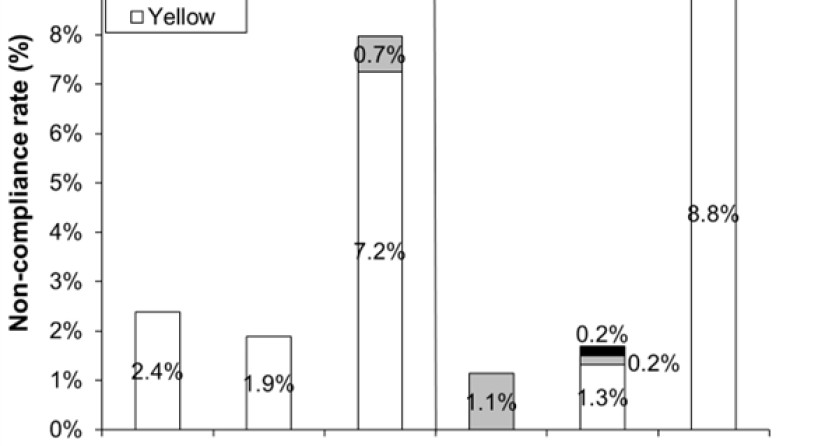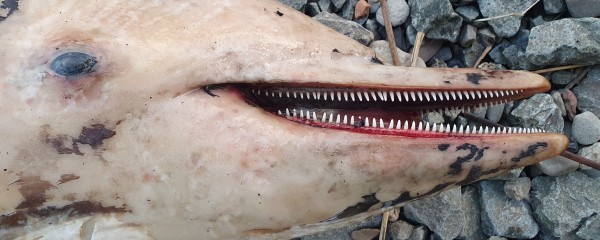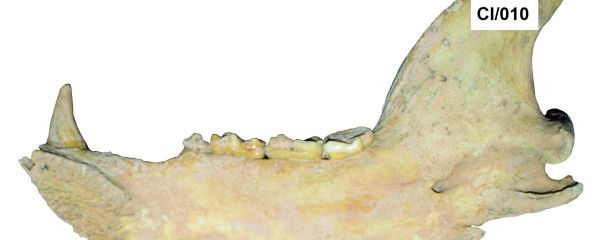Recent sea vessels are emitting more nitrogen in the Belgian North Sea

The Royal Belgian Institute of Natural Sciences (RBINS) has conducted a large-scale study on nitrogen oxide (NOx) emissions from ships in the Belgian part of the North Sea. Our waters are part of a low-emission zone for NOx (NECA) that was established to limit its harmful impact on the densely populated coastal states around the North Sea. The study shows that the majority of ships meet the emission standards. However, the measurements also illustrate that recent ships in Belgian waters have higher average NOx emissions than older ships. This is remarkable given that international regulations aim to reduce NOx emissions in the NECA just gradually, with recent ships having to meet stricter standards than older ships.
With the application of a sniffer sensor in the Belgian air surveillance aircraft, owned by the Royal Belgian Institute of Natural Sciences (RBINS) and frequently deployed within Coast Guard duties, our country is known as a pioneer in the international fight against air pollution from ships at sea. The sensor allows on-site measurement of various air pollutants in ship emissions. Sulphur dioxide measurements have been on the programme since 2016. Since the integration of a NOx sensor in 2020, the aircraft also measures the concentration of nitrogen oxides (NOx).
Need to Reduce NOx Emissions

That obtaining an effective reduction in NOx emissions, including those caused by shipping, is an important objective stems from the negative effects of NOx on public health and our living environment. Nitrogen oxides penetrate deep into the lungs and are a promoter of respiratory and cardiovascular diseases. In addition, they play an important role in the formation of ozone, which is not only a very strong greenhouse gas but can also cause respiratory problems. Furthermore, NOx play a role in the formation of particulate matter. Finally, NOx contribute to eutrophication and acidification of marine and terrestrial environments.
Following the Baltic Sea, the North Sea and English Channel were designated as emission control areas, with the aim of better protecting the densely populated coastal regions and sensitive sea areas of the North Sea states from the ill effects of NOx. As shipping density is very high here, and busy shipping lanes are close to land, the reduction of NOx emissions from shipping is particularly relevant here. Provision 13 of Annex VI of the MARPOL Convention of the International Maritime Organisation (IMO) imposes stricter limits on nitrogen emissions from ships in the North Sea NOx Emission Control Area (NECA) from 1 January 2021. It sets emission limits based on the construction date of ships.
Similar to cars, for which Euro standards are defined based on the year of construction, international maritime NOx emission limits are divided into different levels or 'Tiers'. Tier 0 applies to ships built before 2000, Tier I to ships built from 2000 to 2010, Tier II to ships from 2011 to 2020 and Tier III to ships from 2021 onwards in NECA’s. For ships from more recent age categories, this involves increasingly stricter standards than for older ships. In this way, the NECA expected Tier II ships to emit 20%, and Tier III ships 80%, less nitrogen than Tier I ships.
Results of the Belgian Follow-up
With the deployment of the sniffer plane, Belgium is the only country on a global scale to already map NOx emissions from ships in this way. Two years of NOx measurements of individual ships in the Belgian part of the North Sea show that emission standards are largely met. However, contrary to expectations, it was also found that more recent seagoing ships emit more nitrogen in the operating area of the Belgian air surveillance aircraft than older ships.

In 2020 and 2021, nitrogen emissions from as many as 1407 ships were monitored during 127 flight hours. NOx values that call for further investigation were recorded for 59 of these ships. For instance, it was found that for more recent (Tier II) ships, which have to meet stricter standards, the average nitrogen value was higher than that for older ships (Tier I and Tier 0). Moreover, more Tier II ships were observed with NOx emission values that had exceeded a predetermined threshold.
Explanation and Further Investigation
In cooperation with the Directorate-General Shipping (FPS Mobility and Transport), the shipping industry and the Antwerp Maritime Academy, the RBINS will conduct further research into the possible causes. One explanation already cited in the study lies in the way the regulations have been drafted for Tier II ships, where NOx emissions at lower engine powers have less weight in the set standards (with even no limit at all at powers lower than 25%). The reasoning behind this is that a ship operates mainly on the higher engine powers, and therefore emissions at the higher powers should weigh more heavily. However, in the Belgian part of the North Sea, because of the busy traffic and for optimising their arrival time in port, ships often sail with lower engine power, while NOx emissions (in g NOx/kWh) are higher at the lower powers ... So while more energy-efficient cruising does lead to lower fuel consumption and reduced CO2 emissions, it can, especially for Tier II vessels, also lead to higher NOx emissions. Other pollutants may also increase with lower engine power, such as black carbon and particulate matter. The international regulations that just envisage a reduction in nitrogen emissions thus do not appear to be adapted to the specific sailing conditions in the southern North Sea.
A possible solution to eliminate this unexpected impact of international regulations could be to add a not-to-exceed threshold for NOx emissions regardless of the engine power and construction date of ships. Such Not To Exceed (NTE) limit has been set in the regulations for Tier III ships so there is good hope that this latest generation of ships does lead to NOx emission reductions in our sea areas. The problem remains that even for Tier III ships, no limit was set below an engine power of 25%.


Keel Laying Date
Finally, a weakness in international regulations is that it remains possible to build new ships to old standards for too long. In the regulations, the Keel Laying Year, the year in which a ship's keel is laid and registered, determines which Tier the ship enters. Of all ships built in 2021, barely 13% turn out to be Tier III ships. It was found that the time between construction date and keel laying date increased sharply with the implementation of the NECA in the North Sea in 2021. In this way, recent ships can still enter Tier II and consequently do not have to comply with the stricter Tier III limit that guarantees an effective reduction of NOx emissions (e.g. by applying NOx reduction systems). Therefore, Belgium (and also the Netherlands) will no longer accept ships built from 2026 onwards but with a Keel Laying Year older than 2021 as Tier II ships.

Studies such as this one show that even within a framework of stricter emission standards, shipping needs to continue its efforts to transition from the use of fossil fuels to the use of more sustainable energy sources with less impact on public health, climate and environment.



